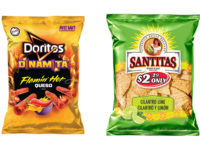The hard pretzel category grew steadily in the past year as consumers stuck at home continued to snack, although fortunes varied significantly from brand to brand. During the past year, consumer focus on cleaner labels and healthier ingredients has ramped up, while manufacturers have continued to experiment with a wider variety of flavors. Pretzel product and ingredient makers predict those trends will continue.
Market data
The overall pretzels category saw 6.0 percent growth to $1.4 billion in sales for the 52 weeks ending May 16, according to multi-outlet data from IRI. Snyder’s of Hanover was the top-selling brand at $489.4 million, up 5.6 percent. Private label brands combined for $246.1 million in sales, up 3.0 percent.
Dots Homestyle Pretzels, the next-highest-selling brand at $160.4 million, nearly doubled in sales from the previous year, up a whopping 91.5 percent. Other top-selling brands did not fare as well—ROLD GOLD saw $130.6 million in sales, but that was down 13.5 percent from a year earlier, while Combos enjoyed $111.4 million, down 9.7 percent.
The Chocolate Covered Salted Snack category, which includes pretzels among other munchables, grew 6.5 percent to $329.0 million in sales for the 52 weeks ending May 16, IRI found. General Mills Chex Mix Muddy Buddies led the category with $77.5 million in sales, up 12.1 percent, while Flipz took in $72.4 million, up 8.9 percent.
Looking back
ADM, Chicago, has evidence that consumers are repeatedly reaching for snacks, says John Powers, marketing director, snacking and baked goods. He cites research from The Hartman Group published in October 2020 showing that 76 percent of consumers report weekly consumption of salty snacks and 70 percent say they’re having sweet snacks that often. About 20 percent say they changed how they snacked in the past year, and 35 percent said they snack more often, “citing reasons such as boredom, more time home and with kids, and to manage stress,” Powers says.
“Throughout the past year, people have relied on familiar flavors, brands, and snacks to provide comfort in a changing world,” he says. “For example, classic flavors provide a sense of consistency and an element of nostalgia. Shoppers often select salty and sweet combinations, such as chocolate-covered or drizzled pretzels, as well as caramel and sea salt, and caramel and dark chocolate coatings. Cheddar cheese, honey mustard, buffalo sauce, and sriracha are popular savory flavors.”
In terms of shape and format, ADM has noticed growth in pretzel thins and pretzel pieces, “which are perceived as a permissible indulgence because the pieces are smaller than more traditional hard pretzel forms,” Powers says. “Portion control also plays a role in packaging. At the height of the pandemic, consumers shifted from individual size to family size bags. Now, there’s a pivot back to the snack pack as people return to their pre-pandemic routines and are looking for convenience and affordability.”
Consumer interest in better-for-you options for pretzels and other snacks has been growing, ADM’s own research has found. More than 70 percent of consumers rate protein from plant sources as healthy, for example, and “plant proteins can be baked right into hard pretzels, using soy, pea, beans and pulses, [or] wheat and peanut flours or powders,” Powers says.
In addition, 46 percent of consumers look for whole grains and 43 percent look for multigrain on snack and baked good ingredient labels, ADM found. “Ancient grains and seeds are a wholesome addition to pretzels and other snacks,” he says. “Product developers can improve the appeal of emerging ingredients like chia, hemp seeds, sorghum, quinoa, and millet by pairing them with more recognizable whole grains like wheat, rice, and oats.”
To create differentiation via product ingredients, ADM’s research has shown that 69 percent of consumers say simple, recognizable ingredients influence their purchasing decisions, and 66 percent say they are looking for simple labels, Powers says. “Additionally parents and caregivers tend to adhere to stricter health-oriented guidelines when choosing snacks for their children, focusing on low sugar as well as a range of free-from labels and clean label-centered cues,” he says. “Hard pretzel brands aiming for clean-label appeal should emphasize ingredient attributes like natural, free from artificial ingredients, and non-GMO.”
Unique Snacks, Reading, PA, spent the pandemic celebrating its 100th anniversary and undergoing a rebrand from Unique Pretzel Bakery, although the company has not produced anything aside from pretzels just yet, says Justin Spannuth, vice president and chief operating officer. The company changed its logo and all package designs, “allowing us to focus on some new business models and new product categories, and allow us to grow,” he says.
Unique Snacks also has seen interest growing on the health side, particularly all-natural ingredients, Spannuth says. “The grain-free, gluten-free, everyone is trying to do something a little different to hit those niche areas,” he says. “In the standard snack area, seasoned products have been doing well, especially anything with a buttery note.”
In addition to high-flavor seasoned product flat pretzel crisps are doing well, according to data, Spannuth says. He adds that the category has seen other types of innovation, such as different options for filled product besides the standard peanut butter, which haven’t necessarily taken off, “but it’s great to see the innovation.”
Betsy Morreale, vice president of salty snacks for the Campbell Soup Company, Camden, NJ, puts numbers on the increases in different shapes and formats, citing IRI Market Advantage data for the 52 weeks ending January 3 that showed a rise in purchases of pretzel sticks (41.4 percent), pieces (17.2 percent) and nuggets (10.5 percent).
Morreale, whose company produces the Snyder’s of Hanover brand, agrees that consumers are striving for flavor-forward pretzel options. “Consumers told us that they were looking for more flavorful, indulgent snacks with complex textures, so we took that insight and ran with it, crafting Twisted Pretzel Sticks, which give bold flavor all in a twisted, crispy crunch,” she says. Released in January, the sticks are available in Jalapeno and Ranch, Sour Cream and Onion, and Seasoned varieties.
Malt Products Corp., Saddle Brook, New Jersey, makes malted barley extract, oat extract and other natural sweeteners with antioxidants, minerals and digestible proteins that help with an improved microbiome, says Amy Targan, president. She believes the most important trend in snacking has been the increase in consumer savviness about what’s in their food.
“Clean label formulations with healthier, all-natural ingredients have been gaining steam in the snack segment for quite some time,” Targan says. “The protracted pandemic-related lockdowns only accelerated this, as it gave consumers more time to consider what they were eating [and] more thoroughly examine ingredients.”
To bring about greater product differentiation through use of ingredients, Malt Products has seen a “push for pantry friendliness” with designations like “no sugar added” and “gluten-free,” she says. MaltRite liquid and dry extracts eliminate the need for genetically modified ingredients used to enhance flavor, color, and shelf life, she adds, while the OatRite brand handles gluten-free applications. Both improve protein, fiber, and mineral content.
Malt Products has noticed a significant expansion and innovation in the pretzel category, with a greater variety of shapes and popularity of flavors like buffalo, jalapeno, and honey mustard, Dijon and sriracha, Targan says. “There’s also a push to further improve upon pretzels’ already positive reputation as a ‘mindful munching’ option compared to other snack foods,” she says.
Ingredient maker Batory Foods, Rosemont, IL, also has noticed greater consumer desire for transparent ingredients as well as “clean” call-outs like gluten-free, says Jamie Mogilner, director of marketing, communications & sustainability. Allergen-free fillings like almond butter pretzel bites are popular, and overall shape trends include pretzel pieces, twists, and filled.
“In addition, we are seeing trends for hybrid of flavors [such as] sweet and savory,” including garlic parmesan as well as strawberry and vanilla yogurt, she says. “We are seeing a lot of holiday-inspired flavors in this category and also familiar paired flavors, such as Pretzel Pete’s Cinnamon Brown Sugar, Bacon Cheddar, and Buffalo Blue. Additionally, there are trends toward indulgent pretzels such as Snappers caramel dark, dark chocolate and sea salt.”
Looking forward
Going forward, ADM expects hard pretzels to remain a snack staple, particularly those with healthier attributes. “Whole grains, low sugar as well as low-sodium, reduced-fat, and gluten-free label plays help position pretzels as a better-for-you choice,” Powers says. He notes that Mordor Intelligence forecasts global pretzel market revenue of $3.3 billion in 2025, with a compounded annual growth rate of 2.6 percent between 2020 and 2025.
ADM believes consumer interest will continue to rise in authentic global flavors like spicy harissa, smoked cinnamon, and sweet and spicy combinations like dark chocolate and chile de arbol, Powers says. “These ethnic flavors allow people to travel through their taste buds, even while they are stuck at home,” he says. “We see this desire for novelty persisting.”
Powers cites Hartman Group data showing that 52 percent of consumers said they had discovered interesting snacks when shopping at new stores or online, and 47 percent of that group said they expect to continue buying those same products after the pandemic ends. ADM sees opportunities for brands to simultaneously meet consumers’ needs for nutrition and the comfort of indulgence, Powers says. “For example, a protein-fortified hard pretzel can meet the desire for a satisfying salty snack while also offering nutritional value,” he says.
Unique Snacks envisions the category moving beyond better-for-you to better-for-the-Earth as consumer environmental interest grows, Spannuth says. “We’ll see greater sustainability of ingredients along with recyclable, compostable, and less plastic packaging,” he says. “We will start to see extreme expansion in the next year or two.”
Unique plans a rollout this summer of a partnership with Troegs Independent Brewing, Hershey, PA, that pairs pretzel and beer at certain retailers, and Unique also will be launching sourdough craft beer pretzels that had been poised for unveiling prior to the pandemic. “We had events scheduled that got canceled,” he says. “They’re getting rescheduled for later this year. We can’t wait.”
Malt Products believes that even as the nation comes out of the pandemic, consumers will continue to desire apportioned snack packs, which will continue to comprise a higher share of overall sales, Targan says. “Even as we emerge from lockdown, many consumers will be hesitant to serve snacks whose consumption requires different people touching the same container,” she predicts.
Malt and oat extracts will continue to be among the only domestically sourceable non-GMO ingredients, she adds, given the continued global supply-chain challenges stymieing the distribution of alternative ingredients like tapioca and rice syrups.
Batory Foods sees significant opportunities going forward for product differentiation through “product mashups,” Mogilner says. These include “hybrid innovation like merging flavors and concepts, and healthier options and free-from claims, such as ‘grain-free,’” she says.







